Tianyang Hu
Noise Consistency Training: A Native Approach for One-Step Generator in Learning Additional Controls
Jun 24, 2025Abstract:The pursuit of efficient and controllable high-quality content generation remains a central challenge in artificial intelligence-generated content (AIGC). While one-step generators, enabled by diffusion distillation techniques, offer excellent generation quality and computational efficiency, adapting them to new control conditions--such as structural constraints, semantic guidelines, or external inputs--poses a significant challenge. Conventional approaches often necessitate computationally expensive modifications to the base model and subsequent diffusion distillation. This paper introduces Noise Consistency Training (NCT), a novel and lightweight approach to directly integrate new control signals into pre-trained one-step generators without requiring access to original training images or retraining the base diffusion model. NCT operates by introducing an adapter module and employs a noise consistency loss in the noise space of the generator. This loss aligns the adapted model's generation behavior across noises that are conditionally dependent to varying degrees, implicitly guiding it to adhere to the new control. Theoretically, this training objective can be understood as minimizing the distributional distance between the adapted generator and the conditional distribution induced by the new conditions. NCT is modular, data-efficient, and easily deployable, relying only on the pre-trained one-step generator and a control signal model. Extensive experiments demonstrate that NCT achieves state-of-the-art controllable generation in a single forward pass, surpassing existing multi-step and distillation-based methods in both generation quality and computational efficiency. Code is available at https://github.com/Luo-Yihong/NCT
Prefix-Tuning+: Modernizing Prefix-Tuning through Attention Independent Prefix Data
Jun 16, 2025Abstract:Parameter-Efficient Fine-Tuning (PEFT) methods have become crucial for rapidly adapting large language models (LLMs) to downstream tasks. Prefix-Tuning, an early and effective PEFT technique, demonstrated the ability to achieve performance comparable to full fine-tuning with significantly reduced computational and memory overhead. However, despite its earlier success, its effectiveness in training modern state-of-the-art LLMs has been very limited. In this work, we demonstrate empirically that Prefix-Tuning underperforms on LLMs because of an inherent tradeoff between input and prefix significance within the attention head. This motivates us to introduce Prefix-Tuning+, a novel architecture that generalizes the principles of Prefix-Tuning while addressing its shortcomings by shifting the prefix module out of the attention head itself. We further provide an overview of our construction process to guide future users when constructing their own context-based methods. Our experiments show that, across a diverse set of benchmarks, Prefix-Tuning+ consistently outperforms existing Prefix-Tuning methods. Notably, it achieves performance on par with the widely adopted LoRA method on several general benchmarks, highlighting the potential modern extension of Prefix-Tuning approaches. Our findings suggest that by overcoming its inherent limitations, Prefix-Tuning can remain a competitive and relevant research direction in the landscape of parameter-efficient LLM adaptation.
Variational Autoencoding Discrete Diffusion with Enhanced Dimensional Correlations Modeling
May 23, 2025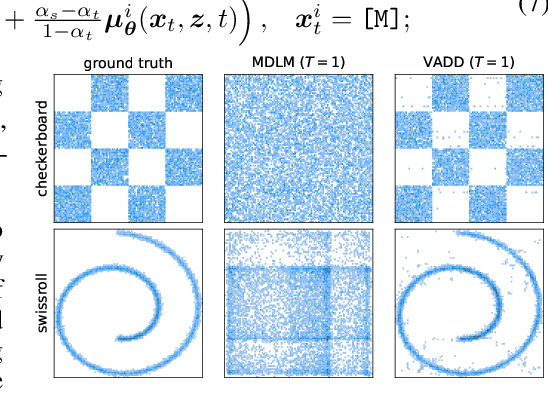

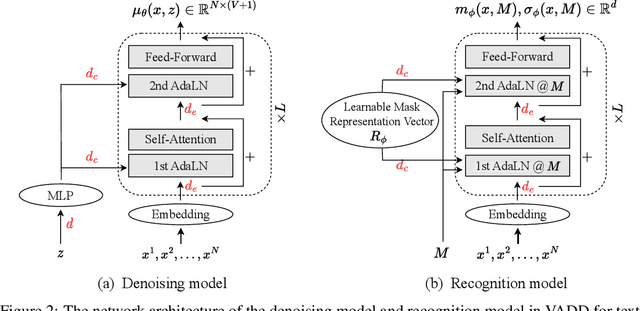

Abstract:Discrete diffusion models have recently shown great promise for modeling complex discrete data, with masked diffusion models (MDMs) offering a compelling trade-off between quality and generation speed. MDMs denoise by progressively unmasking multiple dimensions from an all-masked input, but their performance can degrade when using few denoising steps due to limited modeling of inter-dimensional dependencies. In this paper, we propose Variational Autoencoding Discrete Diffusion (VADD), a novel framework that enhances discrete diffusion with latent variable modeling to implicitly capture correlations among dimensions. By introducing an auxiliary recognition model, VADD enables stable training via variational lower bounds maximization and amortized inference over the training set. Our approach retains the efficiency of traditional MDMs while significantly improving sample quality, especially when the number of denoising steps is small. Empirical results on 2D toy data, pixel-level image generation, and text generation demonstrate that VADD consistently outperforms MDM baselines.
Advanced Codebook Design for SCMA-aided NTNs With Randomly Distributed Users
Apr 07, 2025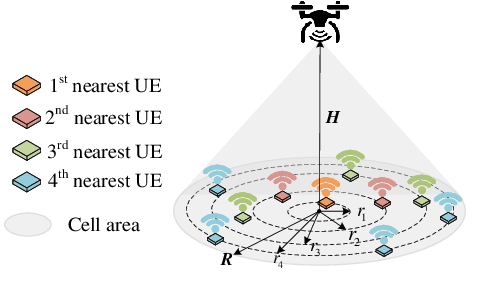
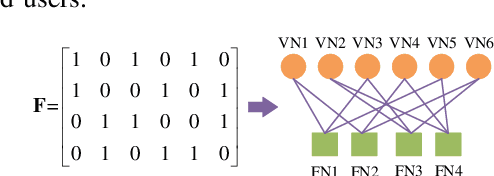
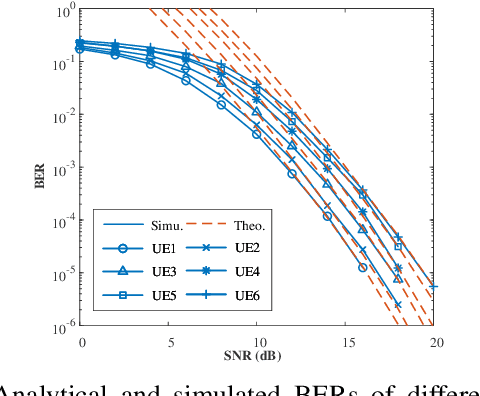
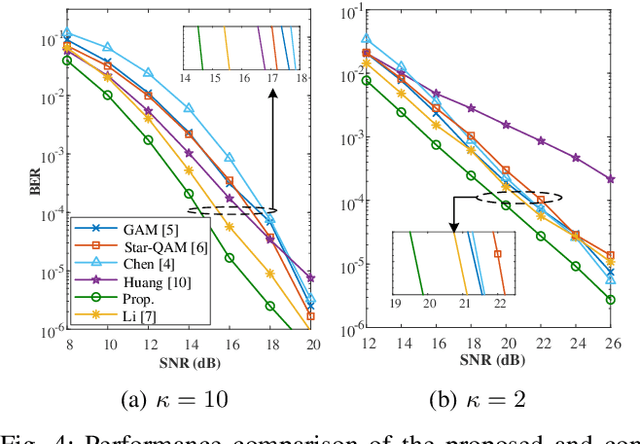
Abstract:In this letter, a novel class of sparse codebooks is proposed for sparse code multiple access (SCMA) aided non-terrestrial networks (NTN) with randomly distributed users characterized by Rician fading channels. Specifically, we first exploit the upper bound of bit error probability (BEP) of an SCMA-aided NTN with large-scale fading of different users under Rician fading channels. Then, the codebook is designed by employing pulse-amplitude modulation constellation, user-specific rotation and power factors. To further reduce the optimization complexity while maintaining the power diversity of different users, an orthogonal layer-assisted joint layer and power assignment strategy is proposed. Finally, unlike existing SCMA codebook designs that treat all users as one super-user, we propose to minimize the BEP of the worst user to ensure user fairness. The simulation results show that the proposed scheme is capable of providing a substantial performance gain over conventional codebooks.
Rewards Are Enough for Fast Photo-Realistic Text-to-image Generation
Mar 17, 2025Abstract:Aligning generated images to complicated text prompts and human preferences is a central challenge in Artificial Intelligence-Generated Content (AIGC). With reward-enhanced diffusion distillation emerging as a promising approach that boosts controllability and fidelity of text-to-image models, we identify a fundamental paradigm shift: as conditions become more specific and reward signals stronger, the rewards themselves become the dominant force in generation. In contrast, the diffusion losses serve as an overly expensive form of regularization. To thoroughly validate our hypothesis, we introduce R0, a novel conditional generation approach via regularized reward maximization. Instead of relying on tricky diffusion distillation losses, R0 proposes a new perspective that treats image generations as an optimization problem in data space which aims to search for valid images that have high compositional rewards. By innovative designs of the generator parameterization and proper regularization techniques, we train state-of-the-art few-step text-to-image generative models with R0 at scales. Our results challenge the conventional wisdom of diffusion post-training and conditional generation by demonstrating that rewards play a dominant role in scenarios with complex conditions. We hope our findings can contribute to further research into human-centric and reward-centric generation paradigms across the broader field of AIGC. Code is available at https://github.com/Luo-Yihong/R0.
Learning Few-Step Diffusion Models by Trajectory Distribution Matching
Mar 09, 2025Abstract:Accelerating diffusion model sampling is crucial for efficient AIGC deployment. While diffusion distillation methods -- based on distribution matching and trajectory matching -- reduce sampling to as few as one step, they fall short on complex tasks like text-to-image generation. Few-step generation offers a better balance between speed and quality, but existing approaches face a persistent trade-off: distribution matching lacks flexibility for multi-step sampling, while trajectory matching often yields suboptimal image quality. To bridge this gap, we propose learning few-step diffusion models by Trajectory Distribution Matching (TDM), a unified distillation paradigm that combines the strengths of distribution and trajectory matching. Our method introduces a data-free score distillation objective, aligning the student's trajectory with the teacher's at the distribution level. Further, we develop a sampling-steps-aware objective that decouples learning targets across different steps, enabling more adjustable sampling. This approach supports both deterministic sampling for superior image quality and flexible multi-step adaptation, achieving state-of-the-art performance with remarkable efficiency. Our model, TDM, outperforms existing methods on various backbones, such as SDXL and PixArt-$\alpha$, delivering superior quality and significantly reduced training costs. In particular, our method distills PixArt-$\alpha$ into a 4-step generator that outperforms its teacher on real user preference at 1024 resolution. This is accomplished with 500 iterations and 2 A800 hours -- a mere 0.01% of the teacher's training cost. In addition, our proposed TDM can be extended to accelerate text-to-video diffusion. Notably, TDM can outperform its teacher model (CogVideoX-2B) by using only 4 NFE on VBench, improving the total score from 80.91 to 81.65. Project page: https://tdm-t2x.github.io/
Adding Additional Control to One-Step Diffusion with Joint Distribution Matching
Mar 09, 2025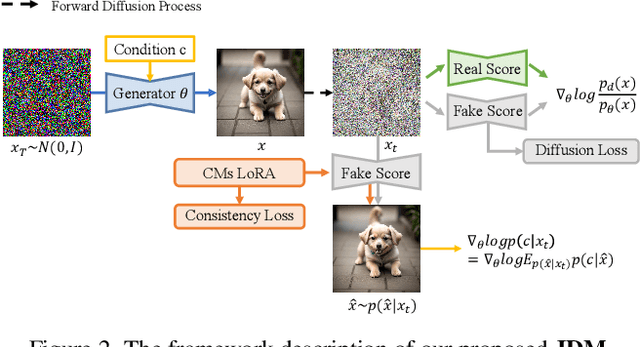
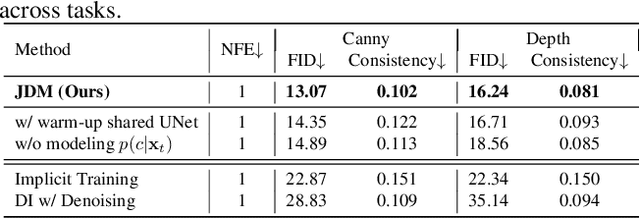
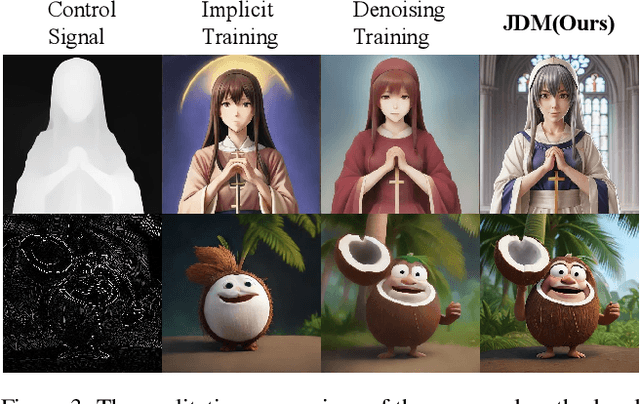
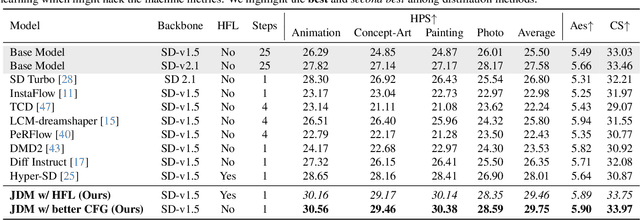
Abstract:While diffusion distillation has enabled one-step generation through methods like Variational Score Distillation, adapting distilled models to emerging new controls -- such as novel structural constraints or latest user preferences -- remains challenging. Conventional approaches typically requires modifying the base diffusion model and redistilling it -- a process that is both computationally intensive and time-consuming. To address these challenges, we introduce Joint Distribution Matching (JDM), a novel approach that minimizes the reverse KL divergence between image-condition joint distributions. By deriving a tractable upper bound, JDM decouples fidelity learning from condition learning. This asymmetric distillation scheme enables our one-step student to handle controls unknown to the teacher model and facilitates improved classifier-free guidance (CFG) usage and seamless integration of human feedback learning (HFL). Experimental results demonstrate that JDM surpasses baseline methods such as multi-step ControlNet by mere one-step in most cases, while achieving state-of-the-art performance in one-step text-to-image synthesis through improved usage of CFG or HFL integration.
Elucidating the design space of language models for image generation
Oct 21, 2024

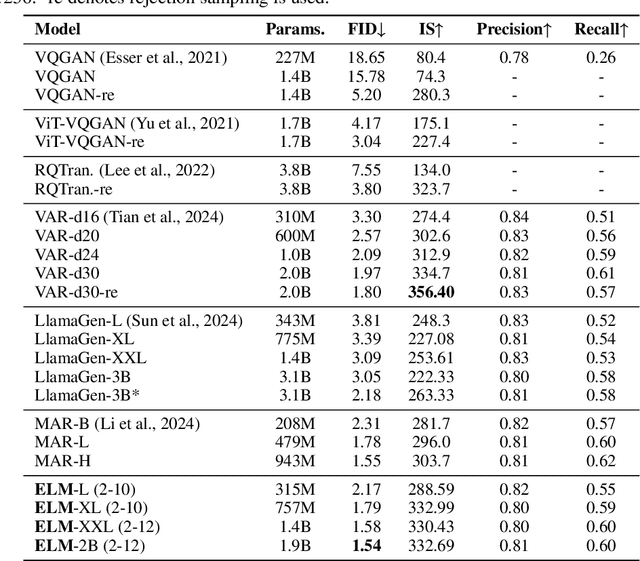
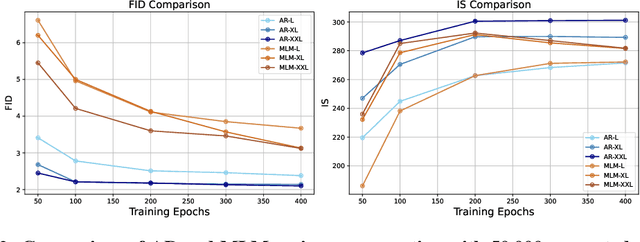
Abstract:The success of autoregressive (AR) language models in text generation has inspired the computer vision community to adopt Large Language Models (LLMs) for image generation. However, considering the essential differences between text and image modalities, the design space of language models for image generation remains underexplored. We observe that image tokens exhibit greater randomness compared to text tokens, which presents challenges when training with token prediction. Nevertheless, AR models demonstrate their potential by effectively learning patterns even from a seemingly suboptimal optimization problem. Our analysis also reveals that while all models successfully grasp the importance of local information in image generation, smaller models struggle to capture the global context. In contrast, larger models showcase improved capabilities in this area, helping to explain the performance gains achieved when scaling up model size. We further elucidate the design space of language models for vision generation, including tokenizer choice, model choice, model scalability, vocabulary design, and sampling strategy through extensive comparative experiments. Our work is the first to analyze the optimization behavior of language models in vision generation, and we believe it can inspire more effective designs when applying LMs to other domains. Finally, our elucidated language model for image generation, termed as ELM, achieves state-of-the-art performance on the ImageNet 256*256 benchmark. The code is available at https://github.com/Pepperlll/LMforImageGeneration.git.
JointDreamer: Ensuring Geometry Consistency and Text Congruence in Text-to-3D Generation via Joint Score Distillation
Jul 17, 2024



Abstract:Score Distillation Sampling (SDS) by well-trained 2D diffusion models has shown great promise in text-to-3D generation. However, this paradigm distills view-agnostic 2D image distributions into the rendering distribution of 3D representation for each view independently, overlooking the coherence across views and yielding 3D inconsistency in generations. In this work, we propose \textbf{J}oint \textbf{S}core \textbf{D}istillation (JSD), a new paradigm that ensures coherent 3D generations. Specifically, we model the joint image distribution, which introduces an energy function to capture the coherence among denoised images from the diffusion model. We then derive the joint score distillation on multiple rendered views of the 3D representation, as opposed to a single view in SDS. In addition, we instantiate three universal view-aware models as energy functions, demonstrating compatibility with JSD. Empirically, JSD significantly mitigates the 3D inconsistency problem in SDS, while maintaining text congruence. Moreover, we introduce the Geometry Fading scheme and Classifier-Free Guidance (CFG) Switching strategy to enhance generative details. Our framework, JointDreamer, establishes a new benchmark in text-to-3D generation, achieving outstanding results with an 88.5\% CLIP R-Precision and 27.7\% CLIP Score. These metrics demonstrate exceptional text congruence, as well as remarkable geometric consistency and texture fidelity.
Exact Conversion of In-Context Learning to Model Weights in Linearized-Attention Transformers
Jun 06, 2024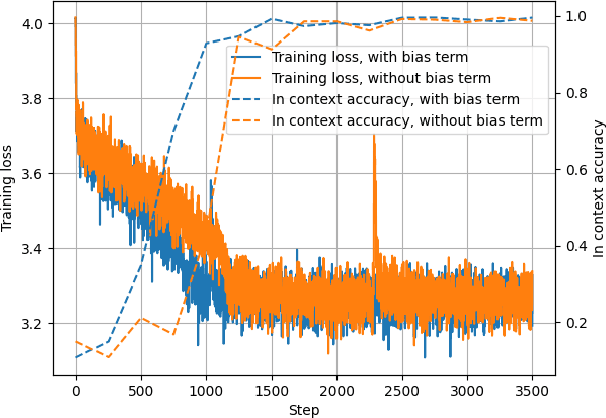
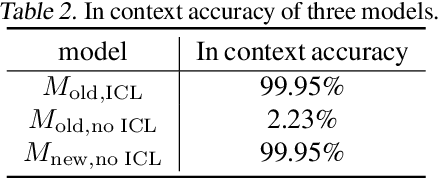
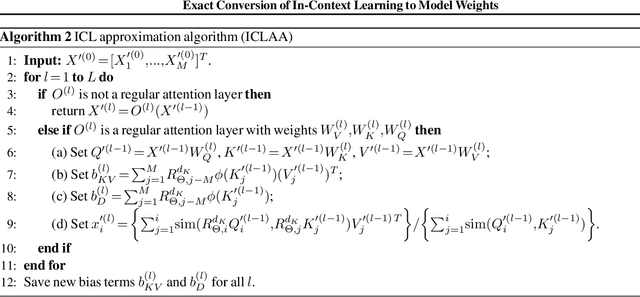
Abstract:In-Context Learning (ICL) has been a powerful emergent property of large language models that has attracted increasing attention in recent years. In contrast to regular gradient-based learning, ICL is highly interpretable and does not require parameter updates. In this paper, we show that, for linearized transformer networks, ICL can be made explicit and permanent through the inclusion of bias terms. We mathematically demonstrate the equivalence between a model with ICL demonstration prompts and the same model with the additional bias terms. Our algorithm (ICLCA) allows for exact conversion in an inexpensive manner. Existing methods are not exact and require expensive parameter updates. We demonstrate the efficacy of our approach through experiments that show the exact incorporation of ICL tokens into a linear transformer. We further suggest how our method can be adapted to achieve cheap approximate conversion of ICL tokens, even in regular transformer networks that are not linearized. Our experiments on GPT-2 show that, even though the conversion is only approximate, the model still gains valuable context from the included bias terms.
 Add to Chrome
Add to Chrome Add to Firefox
Add to Firefox Add to Edge
Add to Edge